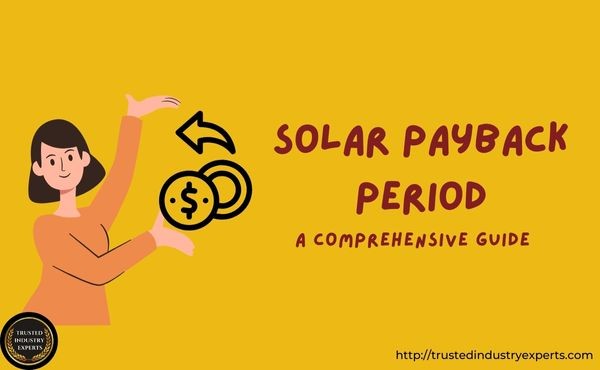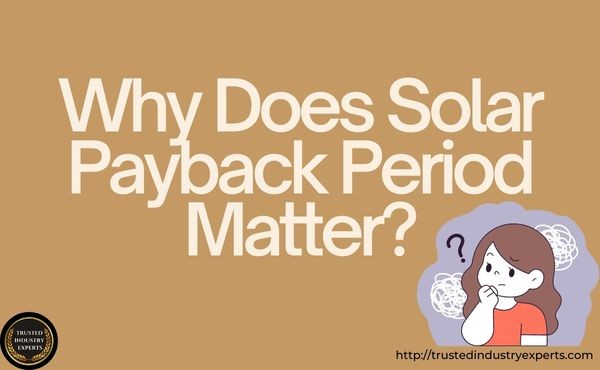Solar Payback Period: A Comprehensive Guide

In this guide, we will discuss what solar payback period is, why it matters, and how you can calculate it. We will also highlight some of the key factors that can affect the payback period of your solar panel installation, such as location, system size, and energy usage.
What is Solar Payback Period?
The solar payback period is the amount of time it takes for the savings you generate from your solar panel system to offset the initial cost of installation. This period typically ranges from 5 to 15 years, depending on the size and efficiency of your solar, your energy production, and other factors that we need to know.
The Solar Payback Period: What You Need To Know
Have you ever wanted to make the switch to solar power, but held back because of the cost? No one wants to invest in something that can take years to pay off. But what if we told you there is a way to get your money back in as little as 5-15 years?
The good solar payback period is the amount of time it takes for the savings you generate from your solar power system to offset the initial cost of installation.
This period typically ranges from 5 to 15 years, depending on the size and efficiency of your solar, your energy costs, and other factors. Let’s explore this concept further.
What Is a Solar Payback Periods?
The solar power payback period is essentially a measure of how long it will take for you to break even on your solar investment tax credit in a solar power system. It starts with an evaluation of all the costs associated with going solar – including equipment costs, installation fees, permits and taxes – and subtracting any available incentives or rebates.
This total number is then divided by how much money you save each year on electricity bills due to generating power with your system.
The result is an estimate of how many years it will take before you start seeing savings from using how many solar panels instead of relying solely on traditional grid power.
Incentives & Rebates That Can Reduce Your Solar Payback Period
When considering switching over to solar energy, be sure to look into any government incentives or rebates available in your area that can help reduce the cost of installing a system and reduce your payback period even further. Additionally, many states offer additional financial benefits such as net metering policies that allow customers who generate their own electricity with renewable energy like solar panels to receive credits for excess electricity sent back onto the grid at retail rate prices.
Furthermore, federal solar tax credits can also drastically reduce the cost of installing a system by up to 30%.
Average payback period
The average payback period for home owners who install a home solar panel is 6-8 years – which means that after just 6-8 years, you’ll start saving money on electricity bills! So don’t wait any longer – make the switch today!
With all the available incentives and rebates out there, now has never been a better time than now for home owners across America looking to go green and save some green!
Investing in a quality home solar panels installed by experienced professionals may be one of the best decisions you ever make for yourself and our environment!
Why Does Solar Payback Period Matter?
Solar power payback period is an important metric for anyone considering investing in solar energy. It can help you determine if the investment is financially viable for you and whether you will be able to recoup your initial costs. Knowing your solar power payback periods can also help you plan your financial goals and make informed decisions about your energy use.

Understand Your Solar Payback Period
Are you considering investing in a home solar system? If so, you’re likely looking for ways to determine if the investment is financially viable for you. Fortunately, it’s possible to calculate your solar panel payback period which can help you understand how quickly you will recoup your initial costs and help you plan your financial goals accordingly. In this blog post, we’ll take a look at why understanding your solar panel payback period is important and how to calculate it.
How Solar Payback Period Works
The concept of a solar payback period is fairly simple—it’s the amount of time it will take for the money saved on electricity bills to offset the total cost of installing a solar energy system. This includes any upfront costs such as installation and equipment, as well as any federal or state incentives that may be available. The goal is to calculate how long it will take for these savings to equal the total cost of the investment.
Calculating your solar payback period
When calculating your solar panel payback period, there are several factors to consider, including the size and type of system you choose, what kind of electricity bill savings you are expecting (i.e., from net metering), what kind of incentives are available in your area, and what kind of loan terms you have negotiated with your lender (if applicable). It’s also important to consider other expenses related to maintenance and monitoring that may arise over time.
Once you have all the necessary information about cost and savings for your particular situation, calculating your solar panel payback period is relatively straightforward—simply divide the total cost by the expected annual electricity bill savings (after accounting for any incentives or loan payments). This calculation can help give you an estimate of how many years it will take before your investment pays off.
Understanding your solar payback period
Understanding your solar panel payback period can be an invaluable tool when deciding whether or not investing in a home solar system makes financial sense for you. By taking into account all relevant factors such as installation costs, energy use, solar loan payments and incentives, you can get an idea of how long it will take for your solar energy investment to start paying off—and make informed decisions about how best to manage both short-term investments and long-term financial goals.
With this knowledge in hand, now all that’s left is finding an experienced solar installers who can help make those goals a reality! Good luck!
Calculating Your Solar Payback Period
To calculate your solar panel payback period, you will need to consider several factors. These include the cost of your residential solar panels, your energy use, the cost of electricity costs in your area, and any available incentives or rebates.
Here’s a simple formula for calculating your solar payback period:
Payback Period = Total Cost of System / Annual Energy Savings
For example, let’s say your solar panel system costs $20,000, and you expect to save $1,500 per year on your electricity bill. Your payback period would be:
Payback Period = $20,000 / $1,500 = 13.3 years
Factors That Affect Solar Payback Period
Several factors can affect the payback period of installing solar panels. These include:
Location
The amount of sunlight your solar panels receive can vary based on where you live. Areas with more sunshine generally have shorter payback periods.
Net metering is a great way to help reduce your solar power payback period. In most states, net metering programs allow you to receive credits for any excess electricity costs generated by your system that’s sent back onto the grid. This can help decrease your overall energy bill savings and shorten your payback time significantly.
Understanding your monthly energy use and annual electricity costs can help you get a more accurate picture of how much money you’ll be saving with solar power over time and can further shorten your good solar power payback time. With the right net metering program in place and a clear understanding of your energy needs, you can make an informed decision about investing in a solar system and reap the rewards for many years to come.
System Size
Larger solar panel systems typically have higher installation costs but can generate more electricity and provide bigger savings over time.
The solar power payback time is an important factor to consider when evaluating a potential solar investment. Knowing how long it will take for your solar system to pay off can help you decide if the investment is worth it and if you should go forward with the project. Factors that affect the payback time include location, monthly electricity bill, system size, net metering programs, and energy usage.
Additionally, incentives such as solar tax credits can help reduce the cost of installing a system and reduce your payback time even further. According to the US Energy Information Administration, the average payback time for home owners who installing solar system is 6-8 years – which means that after just 6-8 years, you’ll start saving money on your monthly electric bill.
By taking all of these factors into consideration and understanding your own energy needs and costs, you can determine if the solar panel ROI is worth it for you in the long run. If so, making the switch from relying solely on traditional power from the grid to using clean national renewable energy laboratory from solar panels may be one of the best decisions you ever make for yourself and our environment!
Energy Usage
Homes with higher energy usage can benefit more from solar installers and have shorter payback time.
Investing in a home solar panel system is an excellent way to reduce your utility bills and go off grid. With the help of a reliable solar company, you can get the perfect sized system for your home that will generate enough power to cover how much electricity usage. Additionally, net metering programs allow you to receive credits for any excess energy generated by your system that’s sent back onto the grid, further reducing your energy bill.
Solar installer can also provide valuable advice on how best to set up and maintain your solar installation, ensuring it’s running at peak efficiency and maximizing potential savings. With all the available incentives and rebates out there, now has never been a better time than now for home owners across America looking to go green and save some green! Investing in a quality solar panel system installed by experienced professionals may be one of the best decisions you ever make for yourself, our environment, and your wallet!
Incentives and Rebates
Federal, state, and local incentives and rebates can help reduce the cost of solar panel installations and shorten payback periods.
In order to further reduce the cost of a panel system, homeowners can opt for grid tie systems, which allow them to connect their solar arrays directly to the electric utility. This allows them to sell excess energy produced by their panels back to the utility, resulting in an even lower utility bill while also producing clean solar electricity that is fed into the grid.
Grid tie systems are becoming increasingly popular and offer economic benefits both on a personal level and at a global level, helping to reduce our reliance on fossil fuels and move towards cleaner energy production.
The solar power payback time is an essential metric to consider when investing in solar energy. Understanding how to calculate it and the factors that affect it can help you make informed decisions about your investment. By installing a panel system, you can save money on your monthly electric bill savings, reduce your carbon footprint, and contribute to a more sustainable future.



